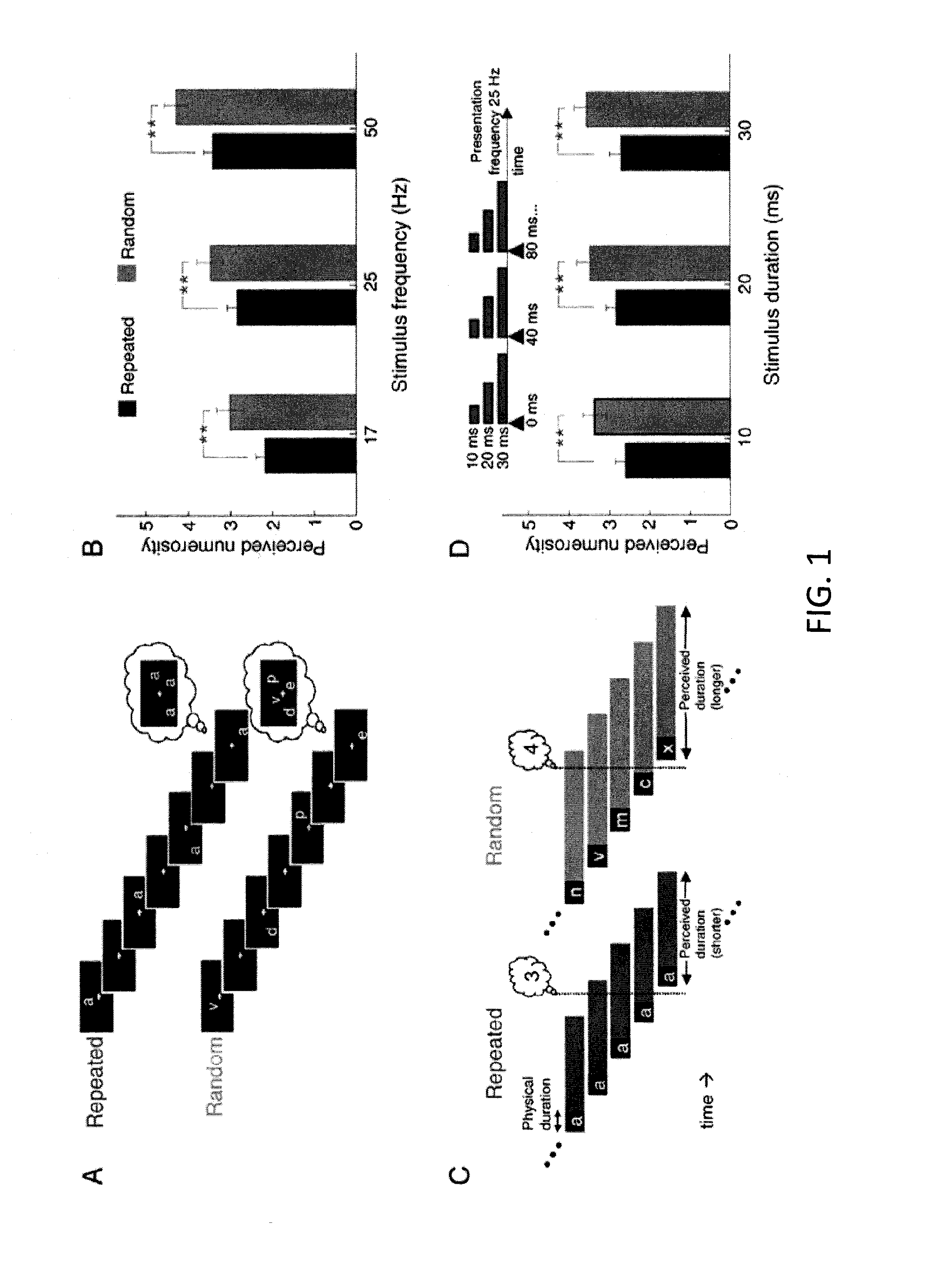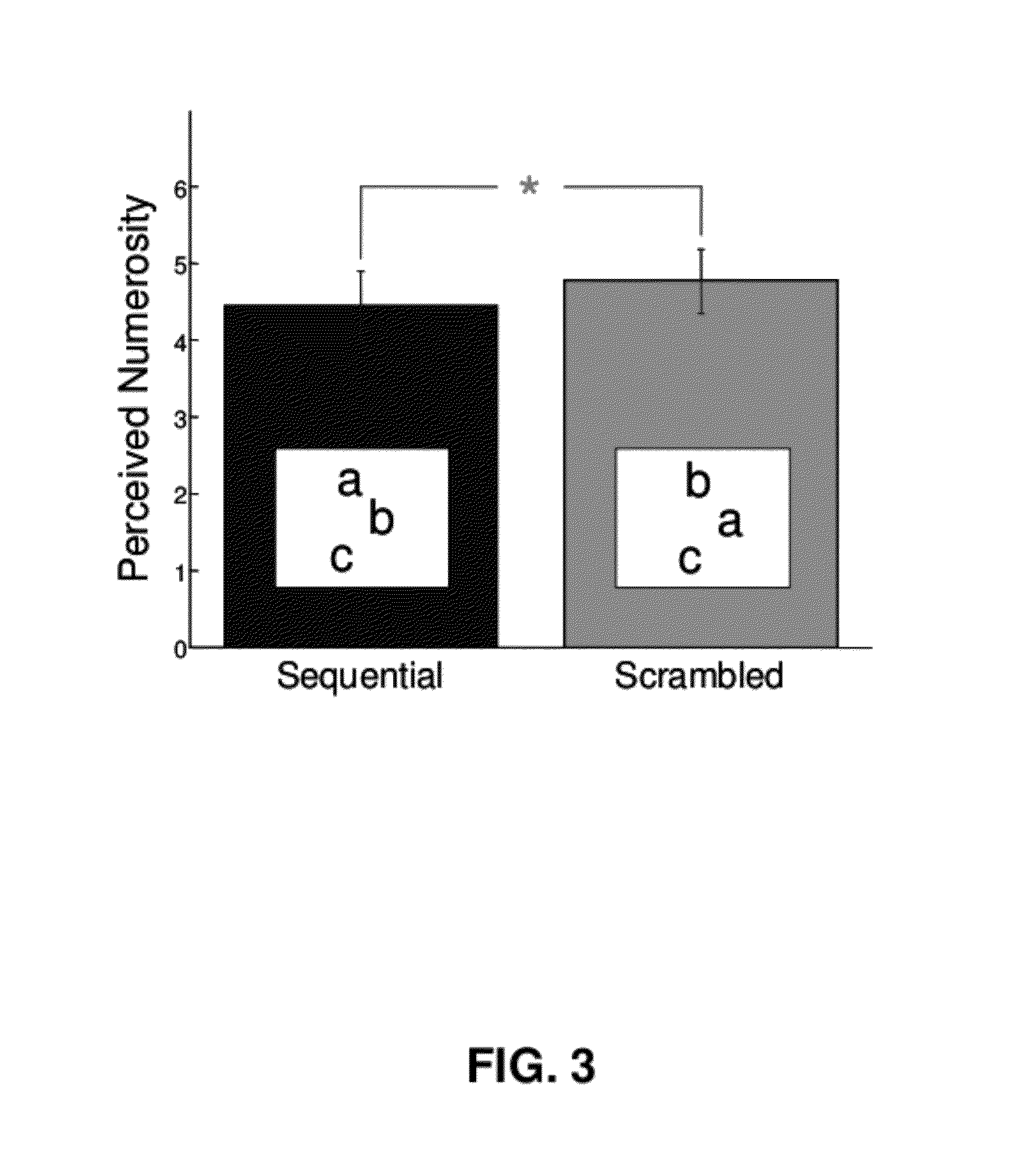Device and method for rapid measurement of repetition suppression in the brain
a technology of repetition suppression and brain, applied in the field of rapid measurement of neural performance, can solve the problems of simple timing task performance compromise, ineffective field, and inability to have a human administrator, so as to reduce the number of stimuli, and reduce the number of temporal overlap.
- Summary
- Abstract
- Description
- Claims
- Application Information
AI Technical Summary
Benefits of technology
Problems solved by technology
Method used
Image
Examples
example 1
Exemplary Materials and Methods for Example 2
[0065]Participants consisted of graduate students and staff between the age of 18 and 45 at the Texas Medical Center with normal or corrected-to-normal vision; all were compensated for taking part in the experiments. Participants sat 59 cm from a CRT computer monitor (refresh rate 100 Hz) and fixated a cross at the center of the screen.
[0066]On each trial, stimuli were flashed one at a time in a randomized location within 6.6° of fixation. In 72 randomly interleaved trials, stimulus durations were 10, 20 or 30 ms (fixed within a trial), and the inter-stimulus interval was always equal to the stimulus duration; this yielded presentation rates of 50, 25 and 17 Hz. To ensure that stimuli were not presented in close proximity on successive frames, each stimulus was presented in a different quadrant from the previous presentation.
[0067]Trials lasted 1320 msec and ended with a mask of white noise. Participants then used a numberpad to report th...
example 2
The Repetition Effects Generalize to Pictures of Objects and Faces
[0074]To determine whether the differential proliferation effect for repeated and random stimuli generalized beyond characters, participants were next presented with variations of the experiment in which the stimuli consisted of photographs of everyday objects (FIG. 2A) or faces (FIG. 2B). In the ‘repeated’ conditions, the same image was serially presented; in the ‘random’ conditions, different images were randomly selected (from a bank of 75 objects or 106 faces). Trial types were randomly interleaved. As in the first experiment, participants perceived fewer stimuli on screen when the stimulus was presented repeatedly as compared with random stimuli (FIG. 2) with an average repeat-to-random ratio of 0.88 in both cases. Therefore, repetition related duration distortions generalize beyond letters.
[0075]As a final control, the possibility that the perception of numerosity is sensitive to similarity or differences among ...
example 3
Exemplary Discussion
[0076]The perceived durations of repeated stimuli are briefer than those of novel stimuli, even when participants are not asked to make explicit temporal judgments. These subjective durations have direct impact on the interpretation of the visual scene: participants perceive a different number of stimuli in repeated and random conditions. Without intending to limit the invention, these perceptual repercussions suggest that distorted durations are assigned on the fly instead of labeled retrospectively.
[0077]The possibility that the data in FIG. 1 might be explained by timing differences between normal apparent motion and transformational apparent motion (in which an object is perceived to change shape as it moves) was considered, but previous studies have found no difference in the strength of apparent motion when using same or different shapes (Burt and Sperling, 1981; Kolers and von Grunau, 1976; Navon, 1976), thus weighing against such an explanation. Moreover,...
PUM
 Login to View More
Login to View More Abstract
Description
Claims
Application Information
 Login to View More
Login to View More - R&D
- Intellectual Property
- Life Sciences
- Materials
- Tech Scout
- Unparalleled Data Quality
- Higher Quality Content
- 60% Fewer Hallucinations
Browse by: Latest US Patents, China's latest patents, Technical Efficacy Thesaurus, Application Domain, Technology Topic, Popular Technical Reports.
© 2025 PatSnap. All rights reserved.Legal|Privacy policy|Modern Slavery Act Transparency Statement|Sitemap|About US| Contact US: help@patsnap.com



